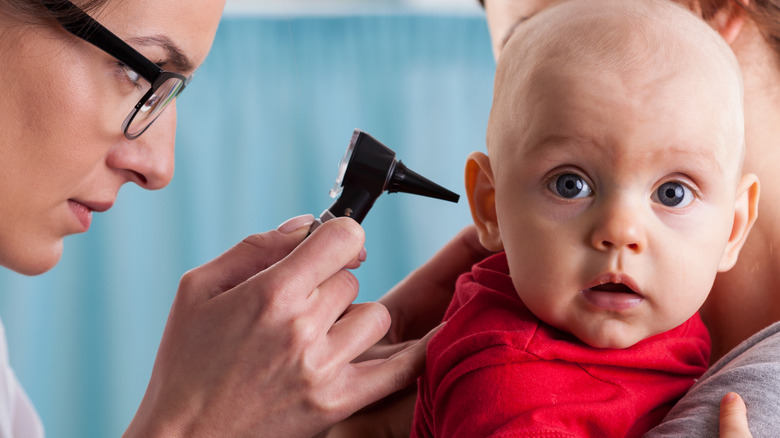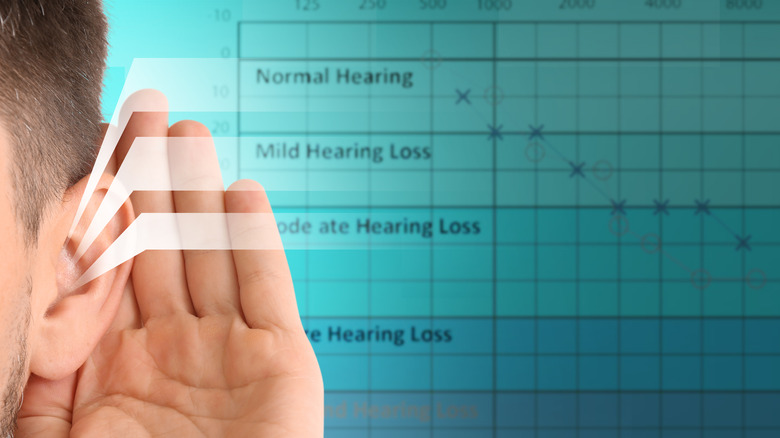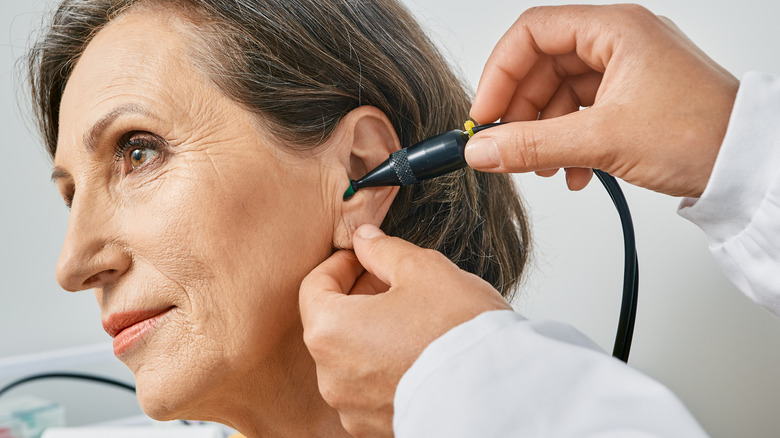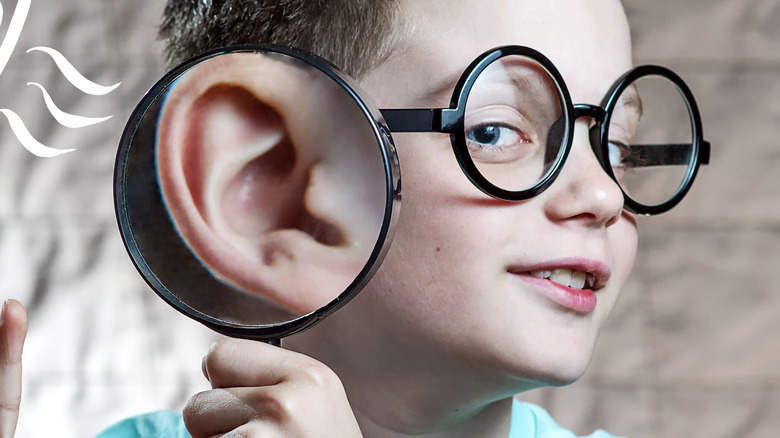Ear Infections Explained: Causes, Symptoms, And Treatments
If you've never had (or rarely have) an ear infection, you might be surprised when you suddenly find yourself with ear pain in one or both ears, possibly accompanied by a sore throat, muffled hearing, or drainage from one or both ears (via Johns Hopkins Medicine). But if you've had ear infections throughout your life or have a child who gets them frequently, your first thought will probably be "Here we go again."
As an adult, you're especially prone to ear infections if you have a cold or allergies, if you smoke, or if you're around someone who smokes. The condition does run in families; older adults are at increased risk, as tissues in the body degenerate during aging, per a 2017 paper in Electronic Physician. People with chronic skin conditions such as psoriasis or eczema are also more likely to get outer ear infections, says Medical News Today.
However, it's infants and small children between three months and three years who most often get ear infections (via the Cleveland Clinic). In fact, about 25% of all children have repeated ear infections that become less frequent around age eight. Babies who are bottle-fed formula instead of breast milk and children who go to daycare centers are at additional risk of getting ear infections (via WebMD).
Ears can get infected for these reasons
Ear infections are generally located in the middle ear, behind the eardrum (via WebMD). When you're healthy and with no sinus congestion, the middle ear is constantly ventilated, cleaned, and dried as you breathe in. Air moves behind your nose and through your eustachian tubes, which connect your middle ear and your throat (per Merriam-Webster). If an eustachian tube is swollen or clogged due to a cold or allergies, the ventilating, cleaning, and drying action doesn't take place, and your middle ear becomes a breeding ground for germs. Ugh!
Acute otitis media (when the middle ear is infected and swollen and there's fluid trapped behind the eardrum) is the most common type of ear infection, says the National Institute on Deafness and Other Communication Disorders (NIDCD). Otitis media with effusion occurs after an ear infection leaves fluid trapped behind the eardrum. And chronic otitis media with effusion is when fluid is lodged in your middle ear for a long time, despite the absence of an infection.
There's also a condition called suppurative chronic otitis, which refers to an eardrum that keeps swelling, draining, or rupturing without letting up (via Penn Medicine).
Children's small ears are more prone to infections
The anatomy of a baby or child's ears explains a lot about why they get more ear infections than adults, per the National Institute on Deafness and Other Communication Disorders (NIDCD). Children's eustachian tubes are smaller, and the tubes are more level than an adult's, which makes drainage more difficult. Add to that swollen or blocked tubes brought on by a cold or other respiratory illness — and the fact that a child's immune system is less able to fight infections because it's still developing — and you've got yourself an ear infection just waiting to happen.
Adenoids also play a role in children's propensity for ear infections, says KidsHealth. Adenoids are a patch of tissue at the back of the nasal passage that traps bacteria and viruses that we inhale or ingest. If they get swollen and infected, they can pass on the infection to the eustachian tubes and middle ear, adds the NIDCD.
This is how to recognize an ear infection in yourself or your child
Let's start with you, since you can readily identify your own symptoms. You may have an earache, which can take the form of ongoing pain or a sudden, sharp pain; ear drainage, or a stabbing pain followed by drainage; or a feeling of fullness in your ear or ears (via WebMD).
Ear infections are harder to recognize in babies or small children because the condition often occurs before they're able to talk and tell you specifically what's hurting. However, there are other signs that can alert you to the problem, per Norton Children's. Your child may be pulling or tugging on their ear, or you may notice they're having trouble with their balance, or aren't hearing as well as usual. Fever, fussiness, crying, or fluid draining from the ear are other tip-offs to an ear infection.
To complicate matters, there are other reasons why your child's ears might hurt besides an ear infection (via the American Academy of Pediatrics). Teething or sore gums are possible causes of ear pain, as is swimmer's ear and inflammation of the eardrum when your child has a cold.
Surprising symptoms that may indicate an ear infection
Ear pain and muffled hearing, combined with a respiratory illness, may have you thinking "ear infection" pretty quickly. But what about snoring and bad breath?
Swollen adenoids often go hand in hand with ear infections, and can contribute to bad breath (halitosis), per the experts at Pinnacle ENT Associates LLC. Why? Because they can block your airway, forcing you to breathe through your mouth. Mouth breathing can lead to bad breath, as well as snoring (via the University of Florida Health).
Dizziness, nausea, and balance problems are also possible symptoms of an ear infection, caused by swelling of the vestibular nerve, a nerve that relays signals related to motion and position to the brain (via StatPearls). And while loss of appetite is pretty common when you're sick, an ear infection may make changes in your appetite even more likely. Aside from losing your ability to taste food, it may also hurt to chew.
How to tell the difference between swimmer's ear and an ear infection
The symptoms of swimmer's ear and an ear infection are similar, but there are a few ways to tell the difference (via Jefferson Health in New Jersey). For example, the medical name for swimmer's ear is otitis externa, which means it's located in the external ear canal, rather than the middle ear (where you'll find most ear infections). If it's painful when you tug on the outside of your ear, there's a good chance you have swimmer's ear. Other symptoms may include swelling and itching in the ear. Additionally, swimmer's ear tends to be more painful than an ear infection.
Water exposure can bring on swimmer's ear, but humidity is also a culprit. Swimmer's ear is more common in the summer, while ear infections are more frequent in the fall and winter. However, if you have seasonal allergies or tend to get chronic infections frequently, swimmer's ear could be your companion at any time during the year.
Swimmer's ear is a bacterial infection caused by liquid getting lodged in the outer ear canal, so drying your ears well after swimming and showering can help prevent the problem, says the Centers for Disease Control and Prevention. Using ear plugs and a bathing cap can keep water out of your ears when you swim. Tilting your head back and forth to let water drain out of each ear is one of several other possible remedies.
Remedies you can try to ease ear infections at home
Minor ear infections usually clear up on their own, but what about your child's, or your own, discomfort while you wait? Luckily, there are home remedies that can help you feel better in the meantime, says the Cleveland Clinic. Hot or cold compresses (whichever is more soothing) are a good go-to, for starters. Put a heat or ice pack, wrapped in a towel to protect your skin, against the affected area. You may also alternate between heat and cold every 10 minutes.
Raising your head above the rest of your body with pillows while you sleep can also relieve discomfort, as can sleeping on your side with the unaffected ear on the pillow. Pain may be eased with less pressure on the ear, and over-the-counter pain relievers such as ibuprofen and acetaminophen can make kids and adults feel more comfortable. Just be sure to use an appropriate dose.
Putting a few drops of hydrogen peroxide in your ear, letting it sit for a few minutes, and then tilting your head and letting it drain out may help with the healing (via HealthPartners). And if you have an outer ear infection, keep hair and blankets away from your ear. That allows airflow on your ear, which can also hasten healing.
Finally, rest is definitely good medicine for an ear infection. Taking it easy and sleeping helps strengthen your immune system so you're better able to fight off the infection.
To see a doctor or not, this is how you decide
If you suspect an ear infection in a baby under six months old, it's time to see a doctor, even if the symptoms don't seem that bad (via Coastal Urgent Care Thibodaux). In adults, pain that doesn't improve after several days is a sign to get medical help, along with experiencing symptoms like swelling under or behind the ear, a fever that's over 100 degrees Fahrenheit, or seizures. If your child has any of these symptoms, it's even more important to get quick medical care, and if they are inconsolable, very lethargic, or develop a stiff neck, contact your doctor immediately (via WebMD).
There are some very good reasons why ear infections shouldn't be ignored, says Penn Medicine. Left untreated, chronic ear infections can lead to hardening of the tissue in the middle ear, which is called tympanosclerosis; damage to the part of the ear related to balance; facial paralysis; and hearing loss. The risk of permanent hearing loss, which is rare, increases with the number of ear infections you or your child get, as well as the length of the infections.
Ear infections are usually diagnosed and treated this way
To diagnose an ear infection, your healthcare provider is likely to check your outer ear, then use a lighted tool called an otoscope to look inside your ear (via Cedars Sinai). A pneumatic otoscope also may be used to send a puff of air into your ear to test your eardrum movement. Movement is decreased if your middle ear is infected or you have fluid lodged there.
There's also a test called tympanometry that's quick and usually painless (unless your eardrum or middle ear is inflamed), which measures how your eardrum and middle ear are functioning and moving (via Healthy Hearing). Tympanometry may also be part of a routine hearing test.
If your child has a mild ear infection, your doctor might recommend waiting to see if the symptoms clear up on their own, or might prescribe an antibiotic with the suggestion that you wait a few days before getting it filled (via the Centers for Disease Control and Prevention). You may find that your child doesn't need the prescription by then. On the other hand, if your child has a severe middle ear infection that lasts longer than two or three days, antibiotics are probably needed right away.
Adults who have ear infections may be treated with antibiotics, taken orally or as ear drops; antihistamines, decongestants, or nasal steroids; and medication for pain (via Johns Hopkins Medicine). Treatment depends on the type of ear infection you have.
Sometimes surgery is recommended if other treatments don't work
Ear infections that last three months or more and get worse rather than better may be a sign that bacteria has become lodged in the ear bone (mastoid bone), requiring surgery (via the University of California, Irvine Department of Otolaryngology).
The Cleveland Clinic defines mastoidectomy as a surgical procedure "that removes diseased cells from the air-filled spaces in your mastoid bone." It's needed when an ear infection spreads to your skull, and it's also used to treat cholesteatoma, a skin growth or cyst located behind the eardrum.
If you have a hole in your eardrum, the odds are good that it will heal without treatment (via the Children's Hospital of Philadelphia). If it doesn't, a myringoplasty — a surgical procedure that repairs the hole by grafting a small piece of tissue over it — may be recommended. Other approaches to repairing eardrums include a tympanoplasty (which involves rebuilding the eardrum and removing scar tissue) and an ossiculoplasty (repairing or replacing the ossicles, the small bones behind the eardrum).
Inserting ear tubes is another surgical procedure that treats ear infections
Frequent or long-lasting ear infections may be treated by surgically inserting tiny metal or plastic tubes in the ear through a small opening in the eardrum. The objective is to allow air to pass through the middle ear and let fluid or pus flow out (via WebMD). Ear tubes are also called myringotomy tubes, pressure equalization tubes, tympanostomy tubes, or ventilation tubes.
Although the need for ear tubes is most common among babies six to 12 months old and becomes rare after a child reaches age eight to 10 (via Texas Children's Hospital), adults sometimes need ear tubes too, says the Cleveland Clinic. A painful condition called barotrauma, often caused by changes in air pressure (e.g., during air travel), can be treated with ear tubes, allowing air into your ear and preventing fluid buildup.
According to the Mayo Clinic, ear tubes typically fall out on their own between four months and one and a half years, and the holes are self-healing. Occasionally, surgery may be required to remove the tubes or close the holes.
Really scary – but pretty rare – conditions that can result from ear infections
Hippocrates, the Greek physician who is credited with being the father of medicine (via Britannica), is believed to be the first to report the potential seriousness of otitis media (ear infections), says Loyola Medicine. And when he said serious, he really meant serious — like getting a brain abscess, becoming delirious, and dying. No kidding!
A brain abscess is when pus accumulates in the brain as a result of an infection, and symptoms may include fever, headache, nausea, vomiting, altered consciousness, and neurologic deficits. Luckily, neurosurgical techniques have come a long way since Hippocrates' time. Nowadays, brain abscesses can usually be drained or suctioned, followed by intravenous (IV) antimicrobial treatment that delivers high concentrations of antibiotics into the tissues quicker than oral antibiotics. During the last half century or so, deaths from brain abscesses have dropped dramatically, and full recovery rates have soared.
Bacterial meningitis is another serious complication of ear infections. It can lead to severe restlessness, delirium, and confusion. Like brain abscesses, it's treated with IV antibiotics.
These are some ways to prevent ear infections
One way to fend off ear infections is to prevent oneself from getting a cold or the flu, which can lead to ear infections (via Johns Hopkins Medicine). Make sure you and your family stay up to date on your vaccines, and away from children and adults who are sick, if possible. Avoid proximity to cigarette smoke and other irritants that can increase your likelihood of getting ear infections, and wash your hands frequently with soap and water and scrub them thoroughly for at least 20 seconds. Humming the "Happy Birthday" song twice may help you time out 20 seconds, says DentistryIQ.
If you have a baby, breastfeeding can help your child avoid ear infections. That's because breast milk contains substances that help protect against infections. And if you're bottle feeding your child, do so while they're sitting up rather than lying down. According to Scripps Health, a horizontal position may lead to milk pooling in the baby's throat, entering the eustachian tubes, and creating ideal conditions for bacterial growth.
Pacifier use has been associated with ear infections, and the American Family Physician (via Scripps) recommends weaning your baby off of a pacifier when they're between six months and one year of age. Also, if your child is in daycare and gets frequent respiratory viruses that lead to ear infections, consider finding a smaller daycare center. The fewer kids and adults, the fewer chances of sharing germs.













